The Sims 3 Border Collie Data Base
SBDB
The breed
For centuries dogs were used to help the shepherd herd his cattle. In the country of origin of the Border Collie, Great Britain, large flocks of sheep are kept all over the country. About a century ago, in the hilly landscape on the border between Scotland and England, a type of dog was developed that is known today as the Border Collie. It's a fast, manoeuvrable, energetic, fast reacting and handy dog that is capable of working all day long wíth the sheep and fór his shepherd in all weathers and on any terrain.
Appearance
During the years some similarity in appearance has developed. The real Border Collie -- in my opinion however -- is not determined by his looks, but by what's inside his head. His ability to herd cattle, the way he herds and his will to work actually determine that he is a Border Collie.
The diversity in exterior between Border Collies is rather large. All kinds of coats between smooth-coat and quite long exist. The colours of a Border vary also very much. The black and white Border, with a white blaze, broad white collar, white front legs, white socks behind and a white end of the tail is the most common. You regularly see this colour with tan marks on head and legs. Merle colours (blue as well as the rare red), chocolate white, sable white, red white, blue white and in all colours the mottled effect (a freckled pattern) can also be found. According to the breed standard any colour is allowed, as long as white does not dominate. Luckily there are people that can't resist a white faced Border (white head or half white head).
Apart from this working type, the last few years more and more attention is given to a show type, that has to follow the breed standard closely. The (by me preferred) pricked ears (upright ears) are not appreciated in the show ring. A short hair Border will not get high marks in a show either.
Character
The character of a Border Collie shows some remarkable points. He excels by his will to work; he can work until he (literally) drops dead. This unbridled energy does not always make him an ideal family pet. When coming home after an exhausting walk (for the owner, that is) of a few hours many a Border will jump out of the car and look expectantly as if he would say "Are we gonna do something or what?".
Something that strikes you in a Border Collie is of course their herding instinct, also known as "eye". Most BCs find their mental and physical satisfaction in working with sheep; coming home after an hour of herding a day they do find their rest at home. If herding is not possible, they can divert their herding instinct on to other objects. Rabbits, cats, other dogs, children, shadows, water and even cars will be used to satisfy this drive. Herding cars is often a deadly game. Children will sometimes be bitten by a BC, because they don't obey the dogs 'commands'. The owner will conclude in many cases that the dog is vicious and has to leave.
A totally different side of the Border also appears frequently. Some describe him as a dog with two faces, because he holds two completely different characters inside. Outdoors he's an indefatigable persevering dog, that is afraid of no-one and takes on any ram. Indoors this sturdy dog becomes a cuddly toy, that likes to spend hours on end lying on your lap or at your feet, while demanding (and receiving) your undivided attention.
Of course not every Border Collie has to work with sheep. If a good alternative to satisfy his will to work is available, he won't cause problems in most cases. Good alternatives are: agility, flyball, obedience, etc. Notice that a daily walk of a few hours is not enough for most Border Collies. If they cannot sufficiently use their mental and physical need to work, they will often show neurotic behaviour. This will result in demolition, barking, yelping and reshaping your couch.
Compared to the long period of time shepherds use dogs for working at the farm, the Border Collie as we know him is quite young.In the nineteenth century we can find several publications in which dogs with the description 'Collie' or 'Colley' are mentioned. Illustrations dating from this time show a varying exterior. Sometimes the dogs look more like the current Scottish shepherd, in other cases they look like the Border Collie, and sometimes it is impossible to recognise a current breed.
At the end of the nineteenth century, you can find a type of 'Colley' that resembles the current Border Collie a lot. With the birth of the legendary Old Hemp in 1893 and Old Kep in 1901, the current Border Collie type has emerged. More about these dogs in the chapter 'The Ancestors'.
The name Border Collie
There is a lot of dispute about the origin of the name Border Collie. According to Gosset1) the origin of the word Collie lies in the word 'Coal'; 'colley' or 'coly' in the English language is related to the colour black.Combe1) on the other hand thinks Collie is a Gaelic word with the meaning 'useful'. In her book she furthermore argues that stories stating that the Border Collie was named after the sheep breed the dogs worked, cannot be confirmed. Nowhere a sheep breed with the name 'colley' or 'coally' can be found.
Another theory takes it yet one step further and relates the word 'collie' to the German 'Kuli'. 'Kuli' is pronounced the same way as the English 'coollie' which means 'worker'. The fact that there is indeed a breed called 'Alt Deutscher Kuli' which works with sheep, makes the story complete. This word 'Kuli' is supposedly coming from 'collaborare' (to collaborate) in Latin. At the time of the Roman occupation, the Gaelic provinces bordered at the Rhine in Germany.
The word Border can be attributed to James Reid—secretary of the International Sheepdog Society (ISDS) from 1915 till 1948. In 1918 he described the winner of the Supreme Championship as Border Collie. It took till 1946 before he mentioned the name Border Collie on the ISDS registration papers.
The first trials
Often, working dogs where compared to each other, but most of the time not beyond the village borders. Therefore a lot of dogs where considered to be excellent shepherds.This changed at 9 October 1873. At a field in Bala (Wales) the first official trial was organised by Richard John Lloyd Price. This first trial was won by James Thompson with Tweed, a black and tan dog of Scottish origin (just like Thompson). Ten dogs competed in the Bala trial, and the event drew some 300 spectators. Interesting detail is that a friend of RJ Lloyd Price—SE Shirley—founded the Kennel Club in the same year. This Kennel Club took care of the pedigree of the Border Collie.
In other parts of the United Kingdom more trials followed fast: Scotland 1874 and England 1876 (Northumberland). The first English trial winner was Walter Telfer, brother of Adam Telfer, who was the breeder of Old Hemp.
In July 1906 the ISDS was founded by twelve top-handlers because of their dissatisfaction with the Kennel Club. In their opinion, the Kennel Club was more focussed on the exterior than the ability to work.
Old Hemp
This dog (born in 1893) served as the model for the Border Collie exterior. His big influence on the breed was caused by his sensational appearance at trials. Since he started trials at the age of one, he never lost one. Old Hemp had a formidable ability to read sheep, and finished every course apparently without any difficulty. The reticent Scots apparently described him as 'bluidy marvellous'.
Actually, it was quite surprising that Old Hemp was this talented. His father—Roy—was a nice dog, but did not posses special talent for herding sheep. His mother—Meg—on the contrary was such an intense worker that she hypnotised herself instead of the sheep. Thus Old Hemp was a typical example of a dog inheriting all the good characteristics of its parents without being burdened by their bad habits.
During the eight years of his life, Old Hemp was a very popular stud dog, supposedly he fathered more than 200 dogs and an unknown number of bitches. A scary high number of offspring, and thus most current Border Collies are somehow descendants of Old Hemp. A factor adding to the success of Old Hemp as stud dog is the fact he passed on his characteristics to his offspring very well. Many of them became successful trial dogs.
Old Kep
In the year Old Hemp died (1901), Old Kep saw the first light of day. One of his contributions to the breed was his kind nature. While the first Borders were a little averse of strangers, Old Kep was the kindest dog.
The genes of Old Kep ended up in the breed through amongst others Herdman's Tommy (ISDS 16), a grandson of Old Hemp. Don (ISDS 11)—a son of Old Kep—was exported to New Zealand where he contributed greatly to the Australian Border Collies.
Old Kep
In the year Old Hemp died (1901), Old Kep saw the first light of day. One of his contributions to the breed was his kind nature. While the first Borders were a little averse of strangers, Old Kep was the kindest dog.
The genes of Old Kep ended up in the breed through amongst others Herdman's Tommy (ISDS 16), a grandson of Old Hemp. Don (ISDS 11)—a son of Old Kep—was exported to New Zealand where he contributed greatly to the Australian Border Collies.
Another contribution of Old Kep to the breed was his 'eye'. His ability to control the sheep with his look resulted in 45 first places at trials.
J.M. Wilson's Cap
J.M. Wilson was a legendary handler and breeder. He bred and trained a large number of champions: Fly (ISDS 824) who became National Champion in 1928; Craig (ISDS 1048), in 1930; Roy (ISDS 1665), in 1934, 1936 and 1937; Glen (ISDS 3940), 1946 and 1948; and Mirk (ISDS 4438), International Champion in 1950.
His most important dog was Cap (ISDS 3036, born in 1937) who was unlucky enough to live during the second World War and therefore never had the opportunity to compete in (inter)national championships. Cap is also known as Wartime Cap.
Furthermore he is the father of J.M. Wilson's Mirk, International Champion in 1950. In the same year J.M. Wilson's Moss and Glen were second and third respectively. In total, Wartime Cap is father to 188 registered pups, of which no less than 112 bitches.
Gilchrist's Spot
Just after the second World War—in 1947—Spot I (ISDS 3624) won the International. With his great style and balance, he was a joy for the eye. His grandson was J.M. Wilson's Mirk (ISDS 4438), and Mirk's grandson in turn was the famous Gilchrist's Spot (ISDS 24981), winner of the Scottish National in 1965 and 1966. His offspring was known for their good character, nice working style and wide outruns. Many champions of the seventies and eighties are descendants of Spot and Wiston Cap.
Wiston Cap
From the lines of J.M. Wilson's Cap, a tri-colour dog was born in 1963 which would become the most often used dog in the history of the Border Collie. Wiston Cap (ISDS 31154) won the International in 1965. Until his death in 1979, he fathered countless pups. Many of the champions in the seventies and eighties were children of Wiston Cap.
Since Wiston Cap was such a valued stud dog, most current BC's are somehow his descendants. Because of this concentration of genes, many recessive characteristics came forward. Amongst them some sought after, like colour factors, but also unwanted, like bad character and diseases like epilepsy, CEA. Furthermore, Wiston Cap contributed to the large number of Border Collies with prick ears. Noticeable here is the fact that all champions he produced were real out-crosses with dogs not related to his ancestors.
♦ The Border Collie ♦
♦ Ancestors ♦
♦ History ♦
♦ Coat Length ♦
♦ Ears ♦
♦ Coat Colours ♦
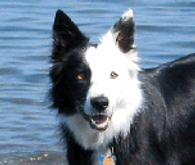
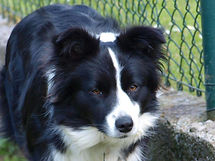





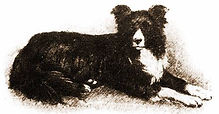

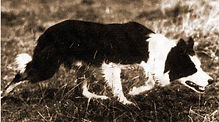
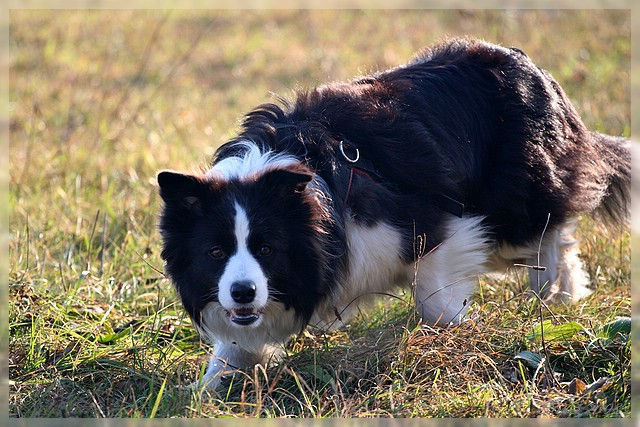
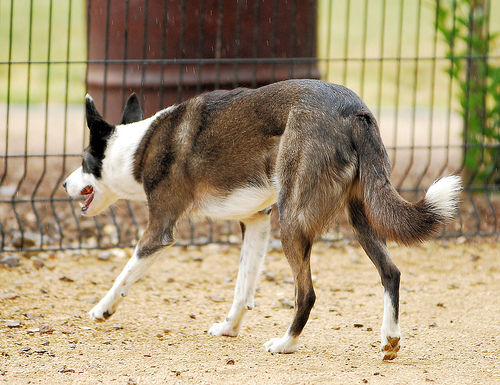
Seal is also called "ghost sable" because the dominant Black is unable to fully express the sable gene.

This is the diluted (lighter) version of Black.

Merle is a modifing gene that causes black patches all over the body. It is dominant over black.

This a merle colour with diluted black patches. It is called Slate because the name Blue Merle was already taken x3

As you can see this is a red dog. It is also called Chocolate and Liver, due the different shadings. This colour is rezessiv over Black.
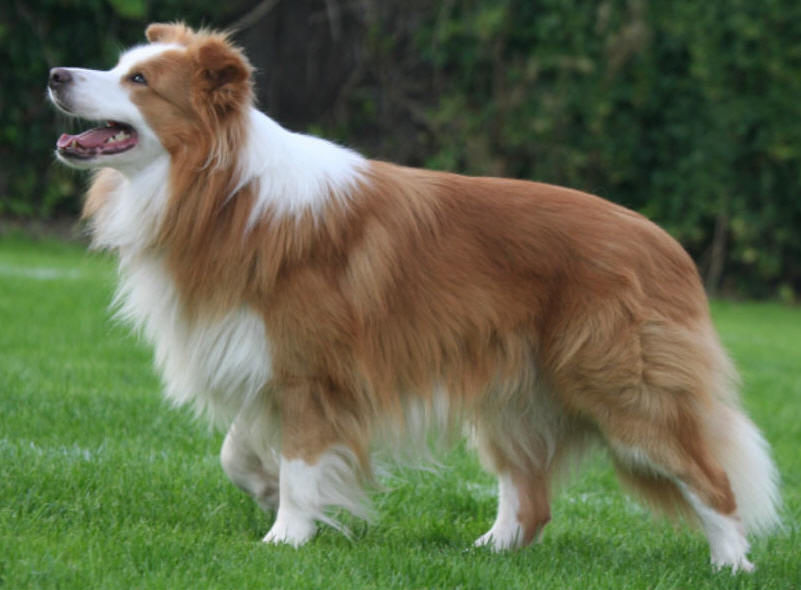
This colour is also called Golden Red and Australian Red. Red ee can express on Black base and on Red base. The nose is than black or reddish. It cant express in compination with Merle or Tricolour!
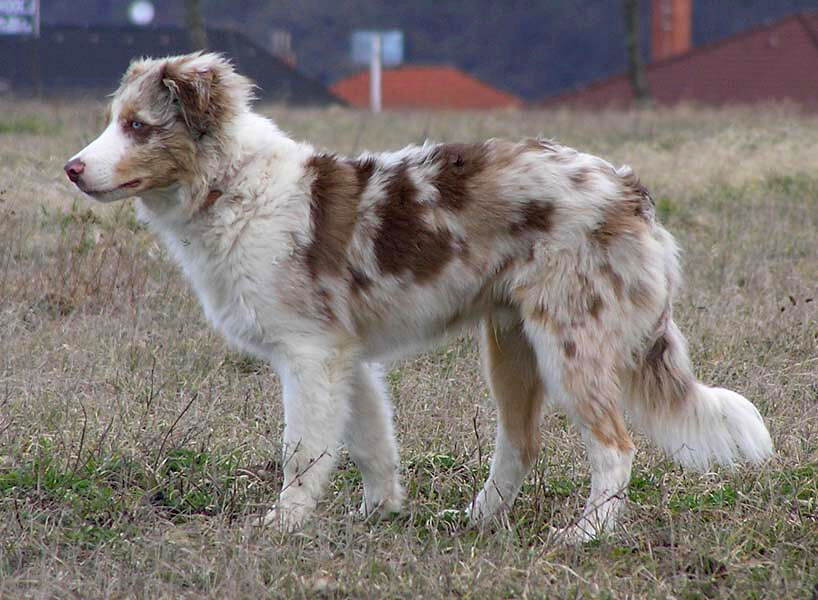
Merle with a red base.
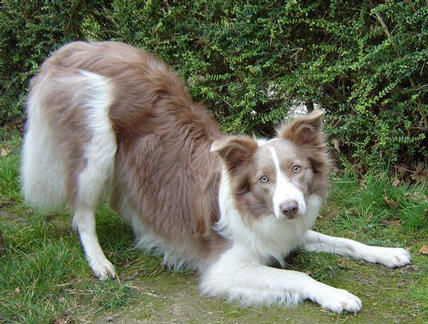
Diluted form of Red.

Merle with lilac base.

Brindle is a dominant gene and can express as Blue, Brown or Lilac Brindle.
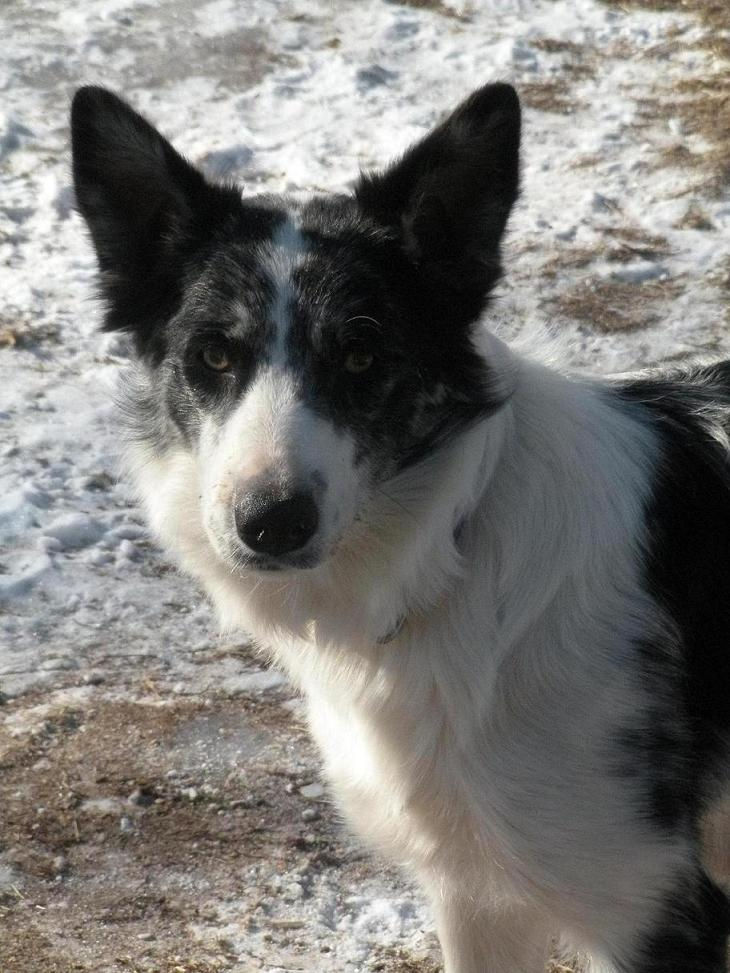



Smooth
Rough
Fully Erect
Semi Erect
Floppy Ears